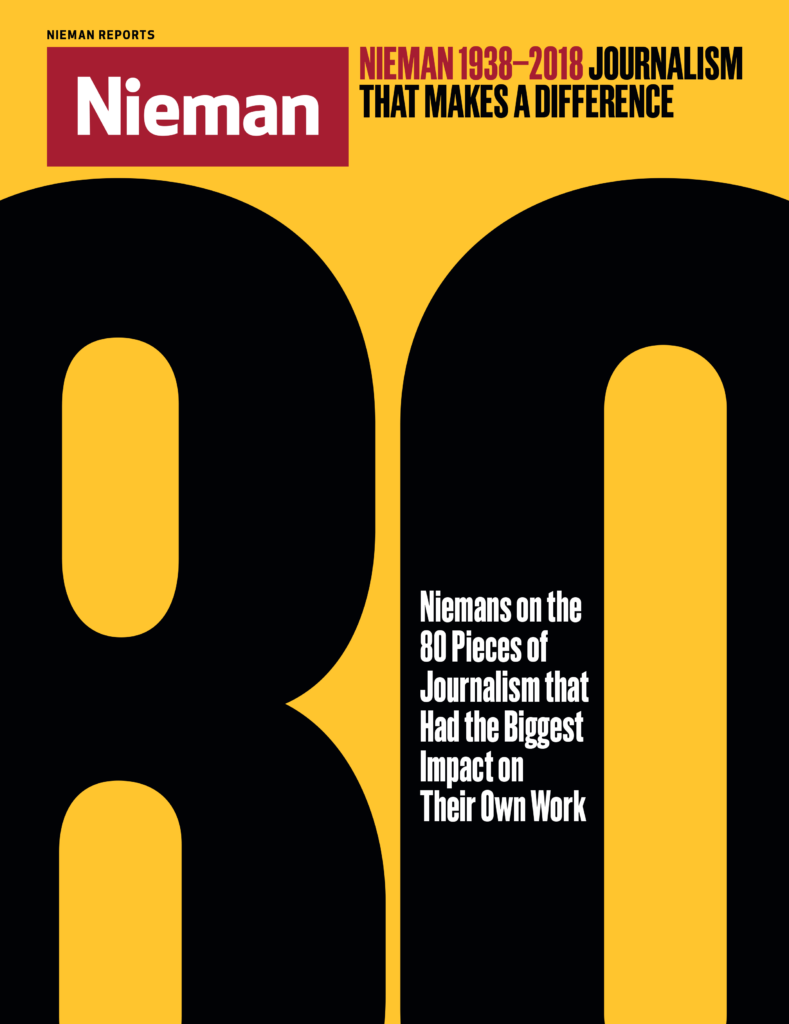
How are great journalists made? Often, it’s pieces of great journalism that help form them, influencing their lives or careers in an indelible way. To celebrate the Nieman Foundation for Journalism’s 80th anniversary in 2018, we asked Nieman Fellows to share works of journalism that in some way left a significant mark on them, their work or their beat, their country, or their culture. The result is what Nieman curator Ann Marie Lipinski calls “an accidental curriculum that has shaped generations of journalists.”
The leadership of our government became unhinged after 9/11/2001. It took me a long time to face that, and even longer to figure out how and why it happened.
I knew Jane Mayer’s Wall Street Journal political reporting and its consistent high quality. She dug deep. She went to The New Yorker and her stories were longer, more detailed, groundbreaking.
She published her book “The Dark Side” in 2008, and the narrative stunned me. She disclosed in startling detail how Vice President Dick Cheney exploited the failures of intelligence and leadership to widen the American national security state, flout the Constitution, roll the Congress, and nudge the press and public to meekly accept torture as national policy.
The effect of the book on us journalists (even retired) was a slow burn that still is smoldering.
The Dark Side: The Inside Story of How The War on Terror Turned into a War on American Ideals
By Jane Mayer
Knopf Doubleday Publishing Group, 2008
Excerpt
Any fair telling of how America came to sacrifice so many cherished values in its fight against terrorism has to acknowledge that the enemy that the Bush administration faced on September 11, and which the country faces still, is both real and terrifying. Often, those in power have felt they simply had no good choices. But this country has in the past faced other mortal enemies, equally if not more threatening, without endangering its moral authority by resorting to state-sanctioned torture. Other democratic nations, meanwhile, have grappled with similar if not greater threats from terrorism without undercutting their values and laws.
But to understand the Bush Administration’s self-destructive response to September 11, one has to look particularly to Cheney, the doomsday expert and unapologetic advocate of expanding presidential power. Appearing on Meet the Press on the first Sunday after the attacks, Cheney gave a memorable description of how the administration viewed the continuing threat and how it planned to respond.
“We’ll have to work sort of the dark side, if you will,” Cheney explained in his characteristically quiet and reassuring voice. “We’ve got to spend time in the shadows in the intelligence world. A lot of what needs to be done here will have to be done quietly, without any discussion, using sources and methods that are available to our intelligence agencies—if we are going to be successful. That’s the world these folks operate in. And, uh, so it’s going to be vital for us to use any means at our disposal basically, to achieve our objectives.”
Soon afterward, Cheney disappeared from public view. But his influence had already begun to shape all that followed.
Excerpt from “Panic” from THE DARK SIDE: THE INSIDE STORY OF HOW THE WAR ON TERROR TURNED INTO A WAR ON AMERICAN IDEALS by Jane Mayer, copyright © 2008 by Jane Mayer. Used by permission of Doubleday, an imprint of the Knopf Doubleday Publishing Group, a division of Penguin Random House LLC. All rights reserved. Reprinted by permission of ICM Partners. Any third party use of this material, outside of this publication, is prohibited. Interested parties must apply directly to Penguin Random House for permission.



